实验3:OpenFlow协议分析实践
实验3:OpenFlow 协议分析实践
一、实验目的
- 能够运用 wireshark 对 OpenFlow 协议数据交互过程进行抓包;
- 能够借助包解析工具,分析与解释 OpenFlow协议的数据包交互过程与机制。
二、实验环境
Ubuntu 20.04 Desktop amd64
三、实验要求
(一)基本要求
- 搭建下图所示拓扑,完成相关 IP 配置,并实现主机与主机之间的 IP 通信。用抓包软件获取控制器与交换机之间的通信数据。

- 在 Miniedit 构建拓扑


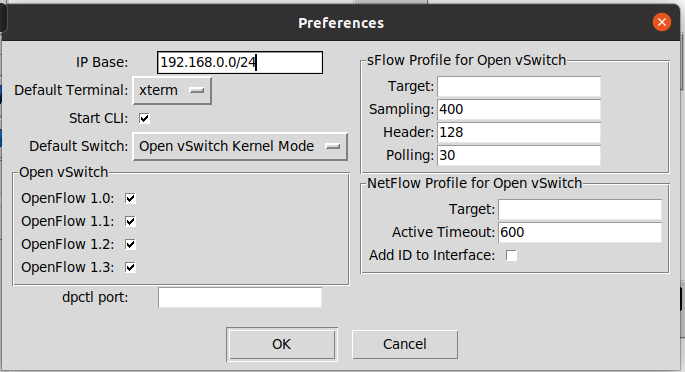
- 查看抓包结果,分析OpenFlow协议中交换机与控制器的消息交互过程,画出相关交互图或流程图。
- OFPT_HELLO
从 6633 端口到 44798 端口,OpenFlow 1.0 协议

从 44798 端口到 6633 端口,OpenFlow 1.5 协议
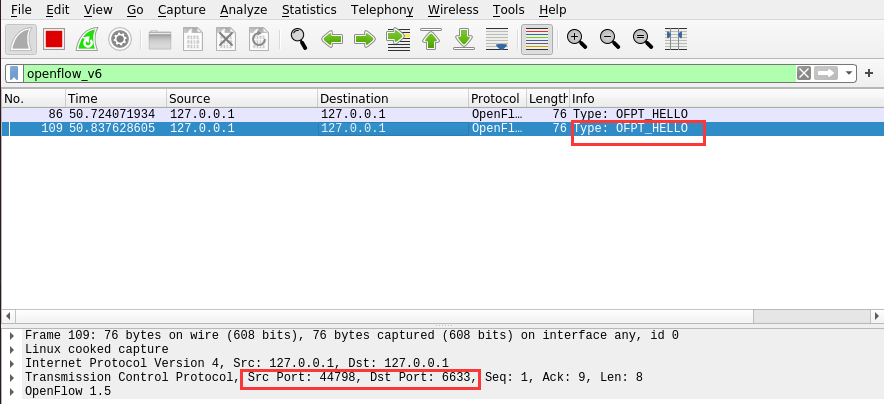
- OFPT_FEATURES_REQUEST
从 6633 端口到 44798 端口,OpenFlow 1.0 协议
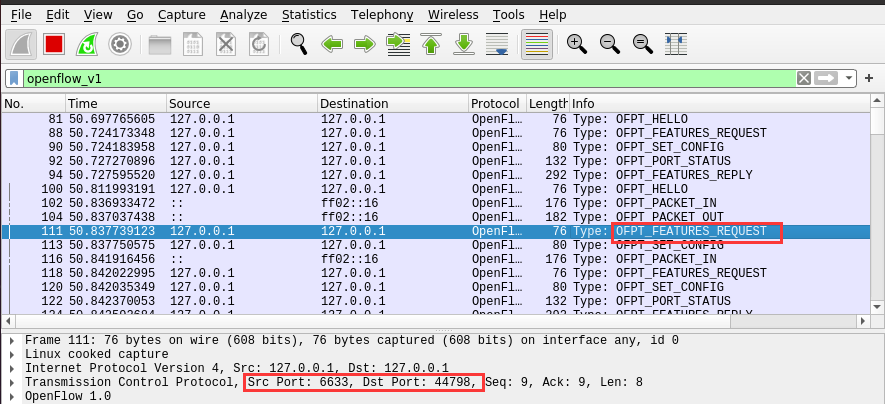
- OFPT_SET_CONFIG
从 6633 端口到 44798 端口,OpenFlow 1.0 协议
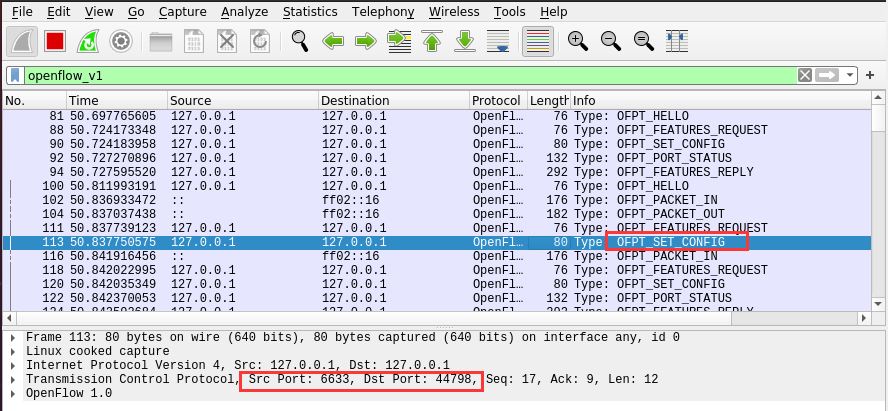
- OFPT_PORT_STATUS
从 44798 端口到 6633 端口,OpenFlow 1.0 协议

- OFPT_FEATURES_REPLY
从 44798 端口到 6633 端口,OpenFlow 1.0 协议
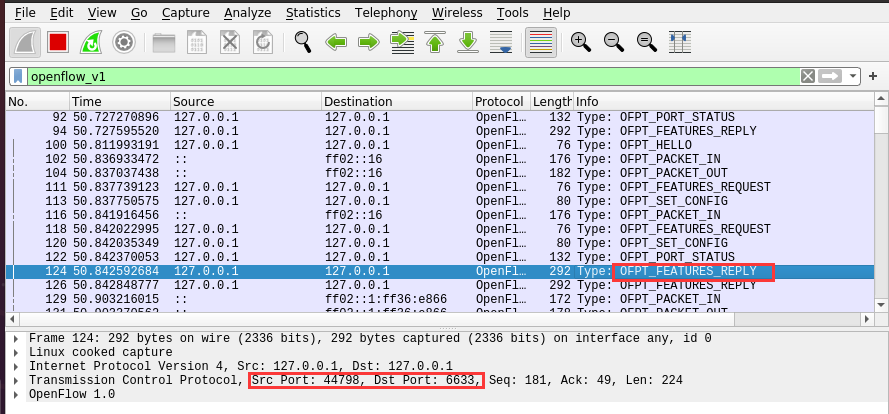
- OFPT_PACKET_IN
从 44798 端口到 6633 端口,OpenFlow 1.0 协议
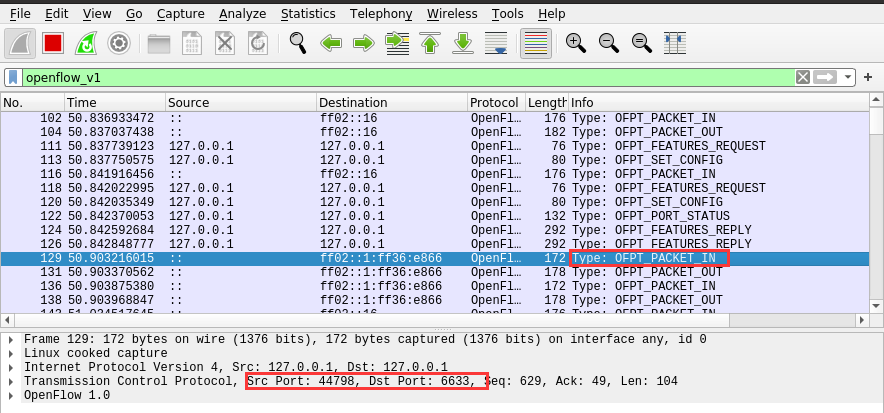
- OFPT_PACKET_OUT
从 6633 端口到 44798 端口,OpenFlow 1.0 协议

- OFPT_FLOW_MOD
从 6633 端口到 44798 端口,OpenFlow 1.0 协议

相关流程图如下:

- 回答问题:交换机与控制器建立通信时是使用TCP协议还是UDP协议?

答:使用TCP协议。
(二)进阶要求
- 将抓包基础要求第2步的抓包结果对照OpenFlow源码,了解OpenFlow主要消息类型对应的数据结构定义。
- OFPT_HELLO
struct ofp_header {
uint8_t version; /* OFP_VERSION. */
uint8_t type; /* One of the OFPT_ constants. */
uint16_t length; /* Length including this ofp_header. */
uint32_t xid; /* Transaction id associated with this packet.
Replies use the same id as was in the request
to facilitate pairing. */
};
struct ofp_hello {
struct ofp_header header;<details>
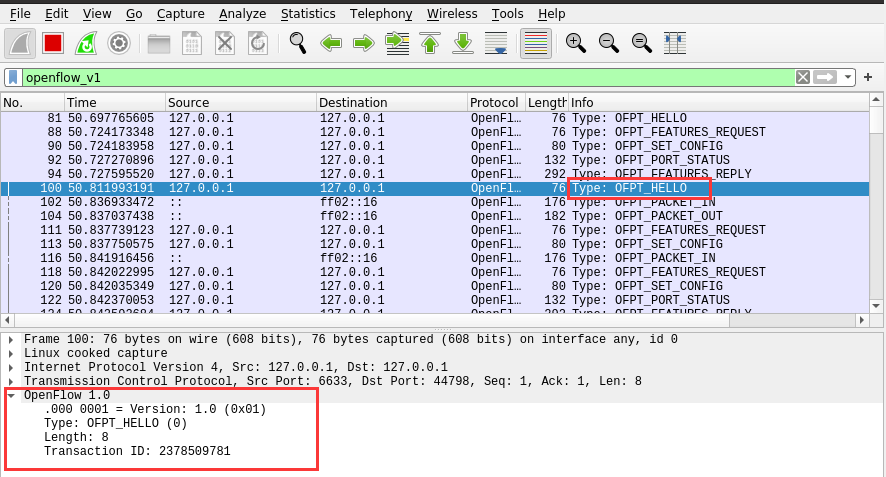
- OFPT_FEATURES_REQUEST
源码与 OFPT_HELLO 类似
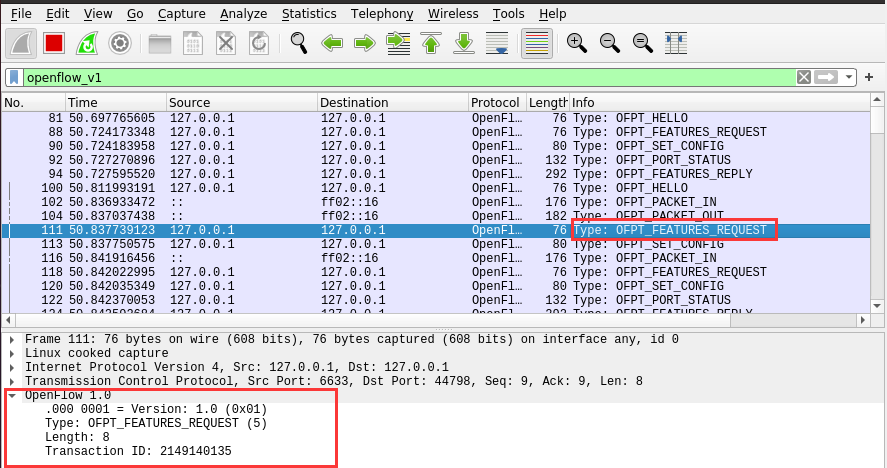
- OFPT_SET_CONFIG
struct ofp_switch_config {
struct ofp_header header;
uint16_t flags; /* OFPC_* flags. */
uint16_t miss_send_len; /* Max bytes of new flow that datapath should
send to the controller. */
};
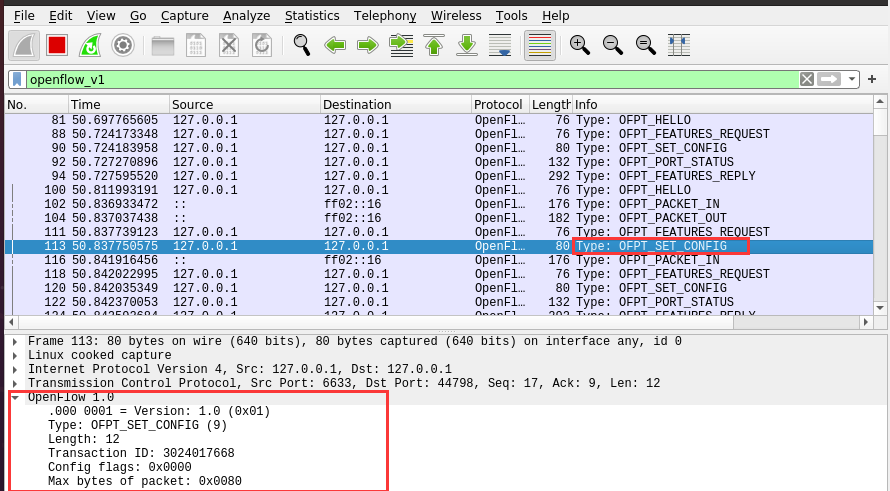
- OFPT_PORT_STATUS
struct ofp_port_status {
struct ofp_header header;
uint8_t reason; /* One of OFPPR_*. */
uint8_t pad[7]; /* Align to 64-bits. */
struct ofp_phy_port desc;
};
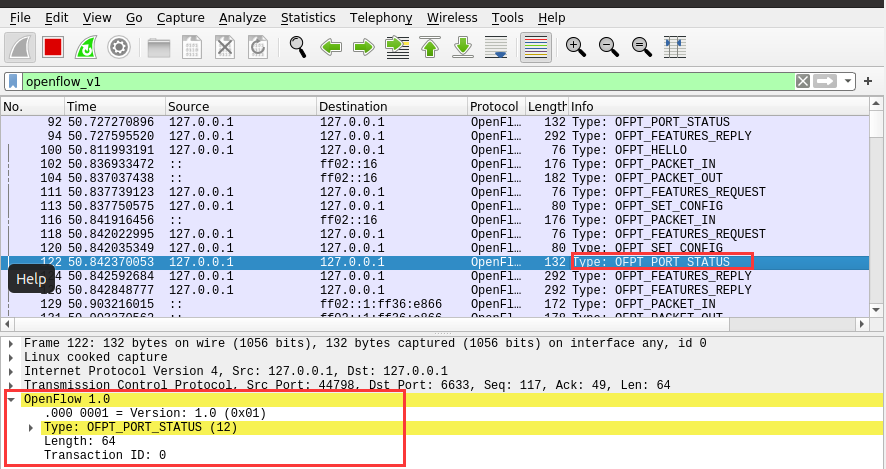
- OFPT_FEATURES_REPLY
struct ofp_switch_features {
struct ofp_header header;
uint64_t datapath_id; /* Datapath unique ID. The lower 48-bits are for
a MAC address, while the upper 16-bits are
implementer-defined. */
uint32_t n_buffers; /* Max packets buffered at once. */
uint8_t n_tables; /* Number of tables supported by datapath. */
uint8_t pad[3]; /* Align to 64-bits. */
/* Features. */
uint32_t capabilities; /* Bitmap of support "ofp_capabilities". */
uint32_t actions; /* Bitmap of supported "ofp_action_type"s. */
/* Port info.*/
struct ofp_phy_port ports[0]; /* Port definitions. The number of ports
is inferred from the length field in
the header. */
};
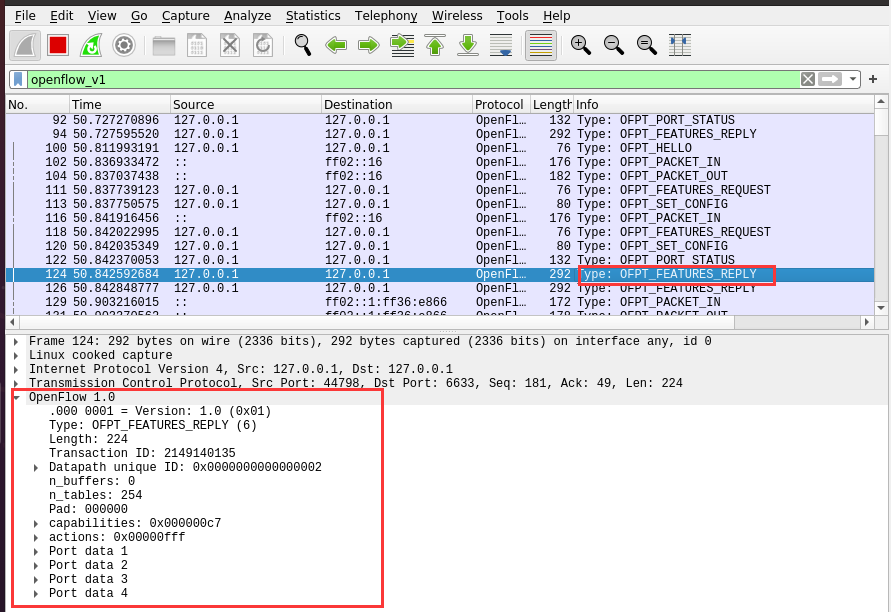
- OFPT_PACKET_IN
struct ofp_packet_in {
struct ofp_header header;
uint32_t buffer_id; /* ID assigned by datapath. */
uint16_t total_len; /* Full length of frame. */
uint16_t in_port; /* Port on which frame was received. */
uint8_t reason; /* Reason packet is being sent (one of OFPR_*) */
uint8_t pad;
uint8_t data[0]; /* Ethernet frame, halfway through 32-bit word,
so the IP header is 32-bit aligned. The
amount of data is inferred from the length
field in the header. Because of padding,
offsetof(struct ofp_packet_in, data) ==
sizeof(struct ofp_packet_in) - 2. */
};

- OFPT_PACKET_OUT
struct ofp_packet_out {
struct ofp_header header;
uint32_t buffer_id; /* ID assigned by datapath (-1 if none). */
uint16_t in_port; /* Packet's input port (OFPP_NONE if none). */
uint16_t actions_len; /* Size of action array in bytes. */
struct ofp_action_header actions[0]; /* Actions. */
/* uint8_t data[0]; */ /* Packet data. The length is inferred
from the length field in the header.
(Only meaningful if buffer_id == -1.) */
};
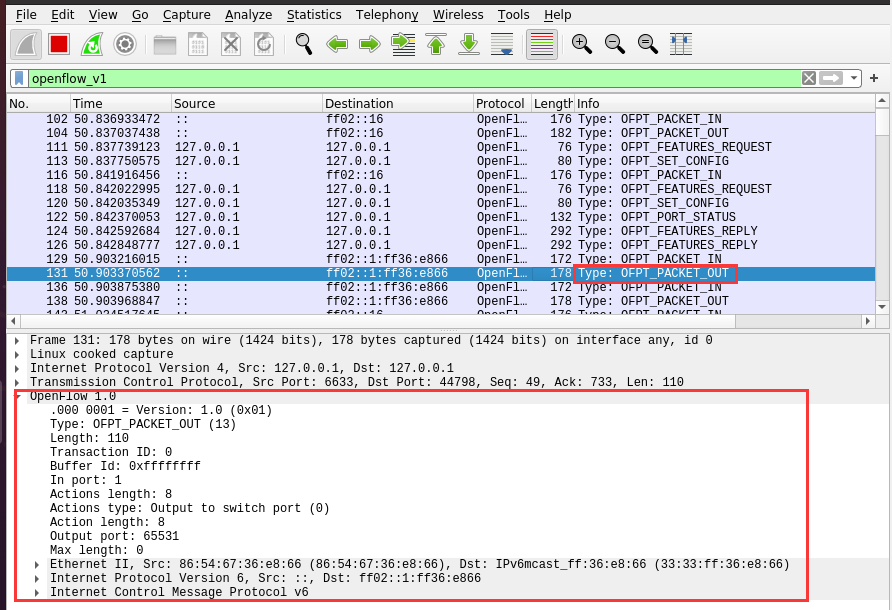
- OFPT_FLOW_MOD
struct ofp_flow_mod {
struct ofp_header header;
struct ofp_match match; /* Fields to match */
uint64_t cookie; /* Opaque controller-issued identifier. */
/* Flow actions. */
uint16_t command; /* One of OFPFC_*. */
uint16_t idle_timeout; /* Idle time before discarding (seconds). */
uint16_t hard_timeout; /* Max time before discarding (seconds). */
uint16_t priority; /* Priority level of flow entry. */
uint32_t buffer_id; /* Buffered packet to apply to (or -1).
Not meaningful for OFPFC_DELETE*. */
uint16_t out_port; /* For OFPFC_DELETE* commands, require
matching entries to include this as an
output port. A value of OFPP_NONE
indicates no restriction. */
uint16_t flags; /* One of OFPFF_*. */
struct ofp_action_header actions[0]; /* The action length is inferred
from the length field in the
header. */
};
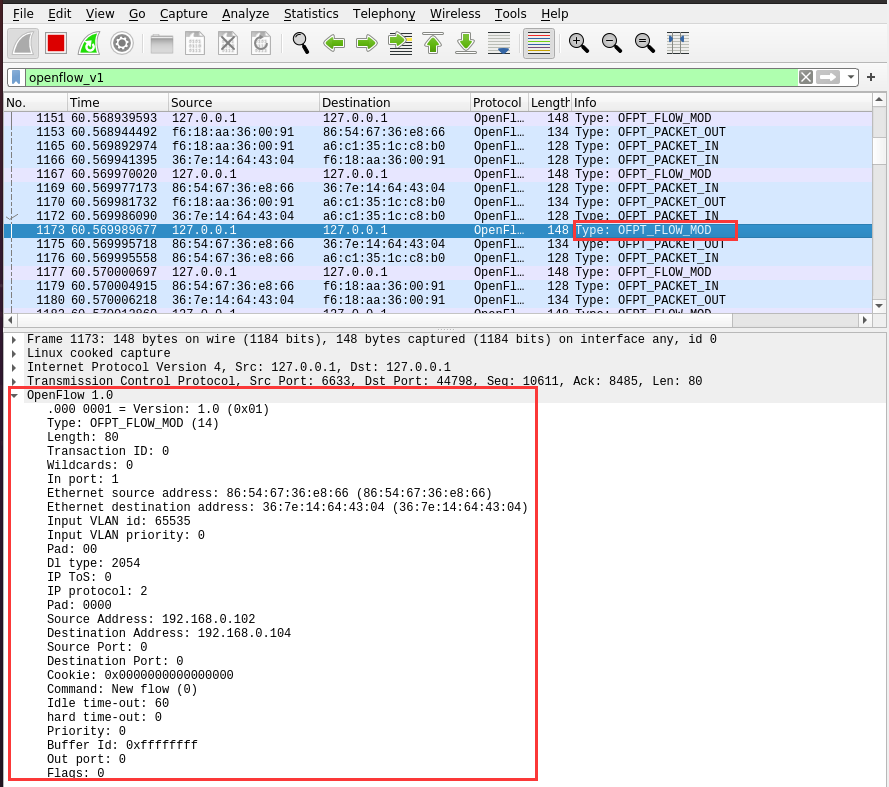
四、个人总结
- 实验难度
本次实验主要是验证性实验,对比之前的实验相对简单。
- 实验过程遇到的困难及解决办法
1、抓包时找不到HELLO数据包
解决办法:先开启抓包再构建拓扑
2、抓包时找不到控制器发送给交换机的HELLO数据包
解决办法:通过过滤器输入“openflow_v6”
- 个人感想
学会了通过过滤器输入“openflow_v1”或“openflow_v6”,过滤出OpenFlow v1.0 或 OpenFlow v1.5 的数据报文,同时进一步熟悉了wireshark抓包工具的使用。基本了解了OpenFlow协议中交换机与控制器的消息交互过程,通过查看OpenFlow源码,大致了解了OpenFlow主要消息类型对应的数据结构定义。




 浙公网安备 33010602011771号
浙公网安备 33010602011771号